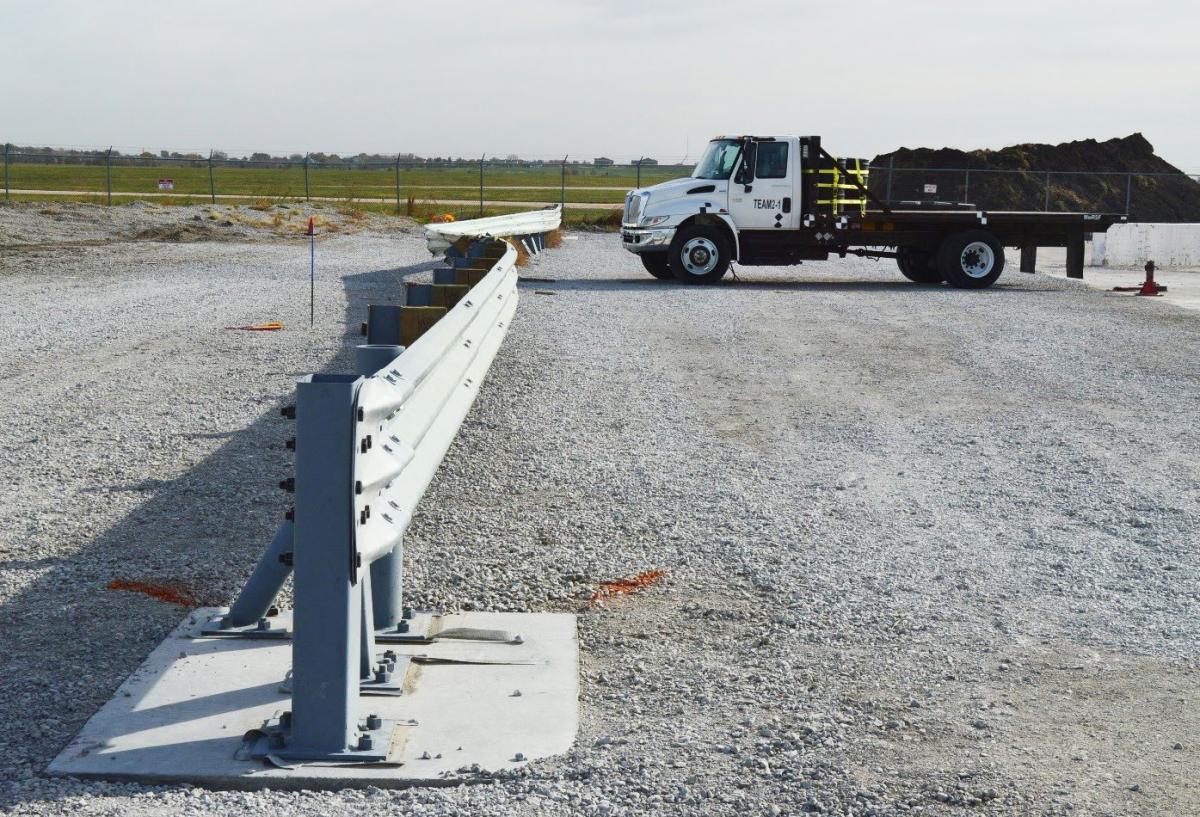
Photo courtesy of MwRSF.
The Nebraska Transportation Center’s Midwest Roadside Safety Facility (MwRSF) has developed a non-proprietary barrier to limit the impact of threat vehicles in Entrance Control Facilities (ECFs) as well as provide safe stops for low-speed, non-hostile vehicles. It will be the first federally-accepted, non-proprietary barrier system in the Department of Defense (DOD) Approved Barrier List. This low-cost, high-performance barrier could reduce new barrier construction costs for military base entrances by 50% and can be quickly repaired using standard construction equipment.
The barrier’s components consist of mostly standard roadside barrier hardware. Corrugated steel plates, called “thrie beam,” form the impact face of the barrier, and are mounted on steel posts embedded in soil. Wood blocks positioned between the post and rail, called “blockouts,” reduce both the possibility of edges of the post tearing through the rail, and the chance of an impacting vehicle’s wheel extending under the rail and snagging a post. The rail is secured to rigid steel and concrete end anchorages to provide up to 150,000 pounds of tension and disable vehicles intentionally trying to breach the barriers by impacting near the end anchorages.
Full-scale crash testing involved using both a medium-duty flatbed truck weighing 15,000 pounds and a 4,500 pound full-size car impacting perpendicular to the center of the barrier. Both vehicles were safely brought to a stop within 10 feet of the initial point of contact.
This barrier is the first non-proprietary system accepted for the DOD Approved Barrier List and was specially designed to be the least expensive option to reduce stress on domestic military construction budgets. The system was also designed to be safe for occupants during accidental impacts, in compliance with the Manual for Assessing Safety Hardware (MASH). System components can be purchased from any vendor to ensure prices stay competitive from the first time the barrier is installed to subsequent repairs and maintenance.
It has been in development for two years beginning December 2015 and completed full-scale and component testing in December 2017. Funding was provided by the Army Surface Deployment and Distribution Command Traffic Engineering Agency (SDDCTEA) and supported by the Army Corps of Engineers Protective Design Center (USACE PDC).
Future evolutions of this barrier may be applied to non-military applications, including urban areas where impact conditions may be severe, such as T-intersections or sharp roadway curves, or to shield high-profile civilian buildings like schools and government buildings.
NTC’s MwRSF will continue to work with SDDCTEA, USACE PDC, and other federal agencies to disseminate research data, develop similar systems for more strenuous impacts, and encourage collaboration and shared research between military structural design innovation and civilian safety design in academia and government. Component and system data generated during this project will be used to inform future projects.
Share your News with NTC!
If you are a student, faculty member, or other affiliate of the Nebraska Transportation Center, we are eager to share your news of your work and accomplishments.
Send your information to Madison Schmidt at mschmidt24@unl.edu and it could appear in NTC's website, newsletter, Facebook, and Twitter.